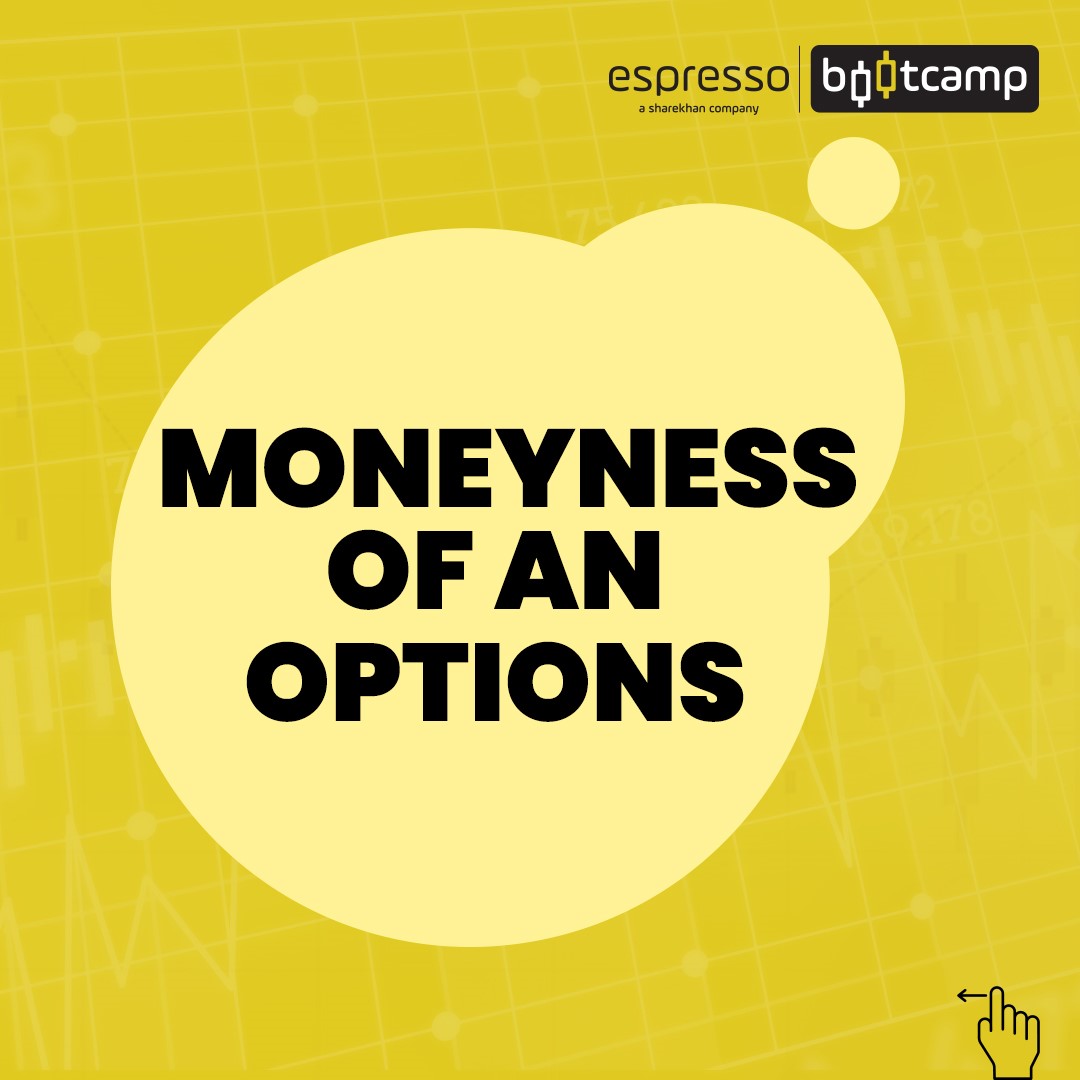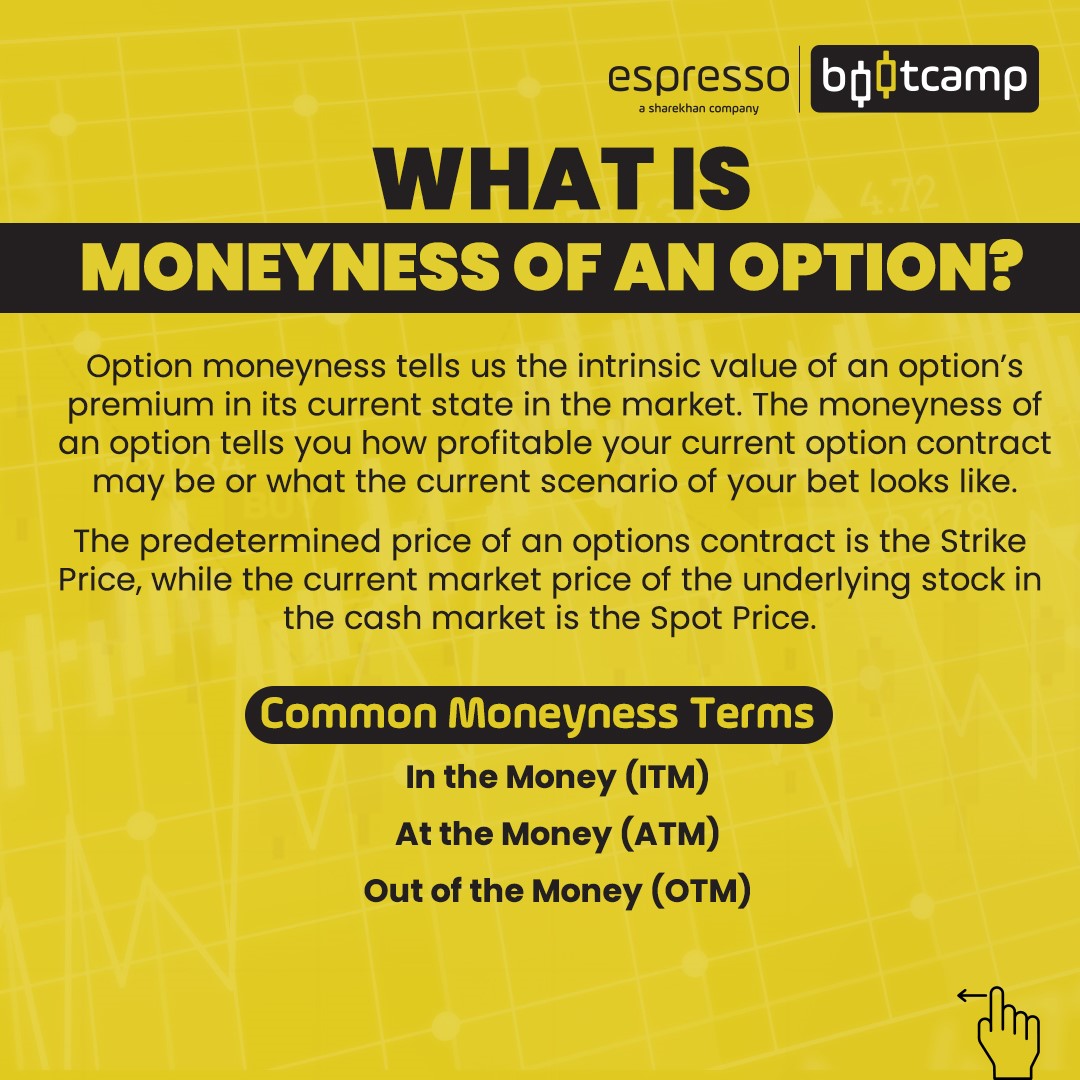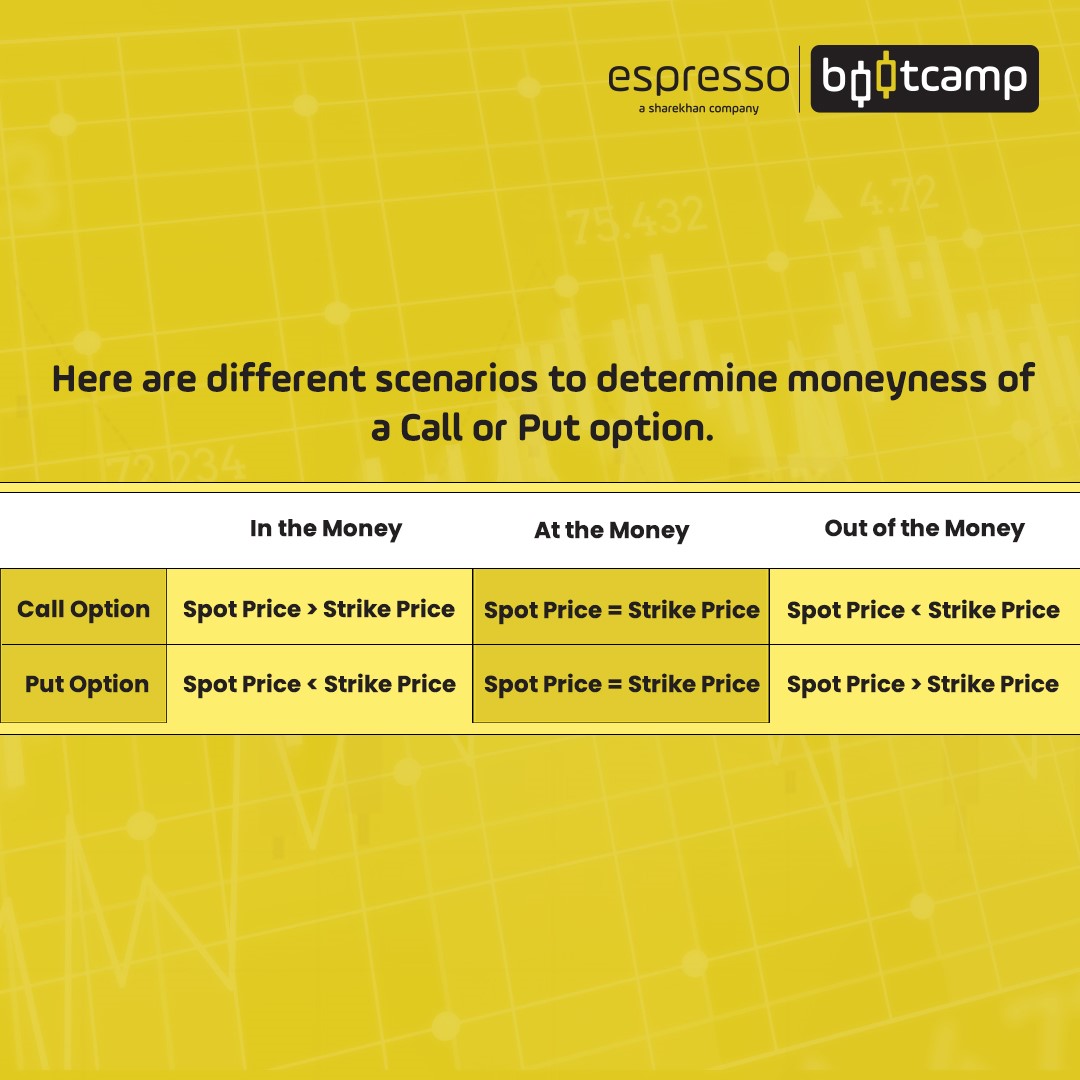Understanding option moneyness is important for options trading, as trading in options is not the same as buying a stock at a discount and selling it at a premium. Being a derivative instrument, options have a shelf life, and are therefore, subject to decay and expiry. As a result, it is not possible to buy or sell an option based on how high or low it is.
Before trading in an option, one must comprehend the idea of the moneyness of the option. If an out-of-the-money option is bought thinking that it is low priced it will most likely end up worthless and result in a loss. Similarly, if an in-the-money option is sold then one may end up making losses if the option price goes up.



Types of moneyness
Options buying and selling are not based on how high or low the price is, but it is based on the moneyness of an option. An options contract's intrinsic worth and the relationship that exists at the current state are referred to as moneyness. At-the-money, in-the-money, and out-of-the-money are three ways to categorise moneyness. Throughout an options contract, the level of moneyness may fluctuate.
At-the-money options
The option that is closest to or equal to the current market price is said to be at-the-money. Both calls and puts, thus, fall under this category. The at-the-money options are prone to volatility and decay since they have just time value and no or very little intrinsic value. Both the call and put options at the money have the same strike price.
In-the-money options
We have already learnt the terms intrinsic and extrinsic worth of an option. In-the-money options are those that have intrinsic value if exercised or expire immediately. In comparison to at-the-money and out-of-the-money options, an in-the-money option is more expensive. This is because they have a sizable level of inherent worth. Additionally, the option will be more expensive the further in-the-money the strike prices are since it will have a higher intrinsic value.
A call option is in-the-money if the strike price is less than the current market price of the underlying stock, i.e., (Current market price – strike price). A put option is in-the-money if the strike price is more than the current market price of the underlying stock, i.e., (Strike price – current market price).
Out-of-the-money options
Options with no intrinsic value are said to be out-of-the-money. Due to the lack of intrinsic value, out-of-the-money options have lower premiums than in-the-money and at-the-money options.
A call option is out-of-the-money if the strike price is more than the current market price of the underlying stock. A put option is out-of-the-money if the current market price of the underlying stock is less than the strike price.

The yellow-shaded portion in the above table is in-the-money option for calls and puts. The white-coloured portion is out-of-the-money call and puts options.
Which option to trade?
It is a common tendency to buy calls if you are a beginner. Call buying gives you the advantage of leverage as only a small fraction of the amount goes into buying a call, unlike buying a stock. Leverage can be a double-edged sword that greatly enhances both returns and losses. Thus, one must be extremely careful when deciding how much money to invest. Additionally, the risk is restricted to the extent of the premium paid. All is well when the price moves in your favour. However, if it doesn't, the option decays, and that may result in losses. So, the question is which option to buy.
Investors must choose which option to utilise, i.e., in-the-money, at-the-money, or out-of-the-money strike prices based on the target price for the underlying stock. Out-of-the-money options may look alluring since they are less expensive. However, the possibilities of making money at expiration are less than for at-the-money or in-the-money options. One cannot zero down on the ideal choice. The target price is the primary factor in determining the strike price.
Target price and time horizon
A call option is bought with a bullish bias, and the target price is also usually known. With a significant increase in the price of the underlying stock, out-of-the-money options perform better. However, if you anticipate a modest gain, at-the-money or in-the-money options are great choices.
Apart from this, it is also important to know the time horizon, i.e., by when the target price would be achieved. This is because of the decaying nature of the options. While buying short-term options, it is commonly seen that the stock price moves up after the expiry. However, by buying a longer expiration option, it is possible to eliminate this risk, as there is time to exit a position if the profit target is achieved, and if not, one can adjust the exit with a small stop loss.
Call option for August end expiry
| Strike price | Moneyness | Premium | Target | Intrinsic value | Profit | Return% |
| 17400 | In-the-money | 350 | 17800 | 400 | 50 | 14% |
| 17500 | At-the-money | 287 | 17800 | 300 | 13 | 5% |
| 17600 | Out-of-the-money | 231 | 17800 | 200 | -31 | -13% |
In the above example, one can see that the in-the-money option gives a better return if the target price is achieved at expiry. However, if the target price is 18,000 at expiry, the at-the-money and out-of-the-money call options give better returns.
Call option for August end expiry
| Strike price | Moneyness | Premium | Target | Intrinsic value | Profit | Return% |
| 17400 | In-the-money | 350 | 18000 | 600 | 250 | 71% |
| 17500 | At-the-money | 287 | 18000 | 500 | 213 | 74% |
| 17600 | Out-of-the-money | 231 | 18000 | 400 | 169 | 73% |
Conclusion
Clarity on option moneyness is key to options trading. There are no perfect ways to trade options as it depends on the trader’s perception of the price movement and the time to expiration. Implied volatility also plays an important role in option pricing. Options should be bought at the lower implied volatility and sold when implied volatility is higher. Options with higher implied volatility are expensive, and therefore, if the implied volatility falls despite an increase in the price of the underlying, the option price may also fall.
Things to remember
- An options contract's intrinsic worth and the relationship that exists at the current state are referred to as moneyness. At-the-money, in-the-money, and out-of-the-money are three ways to categorise moneyness.
- Clarity on option moneyness is key to options trading.
- There is no optimum way to trade options as it depends on the trader’s perception of the price movements and the time to expiration. The target price is the primary factor in determining the strike price.
 0
|
0
|
 0
0
 Modules
Modules

 Watch
Watch 
